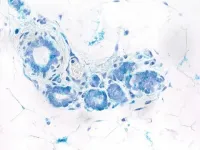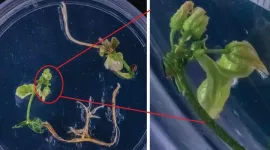(Press-News.org) Early diagnosis and improvement of breast cancer treatments have reduced breast cancer mortality in recent years, with survival rates reaching 85% today. In spite of these data, breast cancer was still the most frequently diagnosed tumour in the world in 2020, mainly due to increased population screening and social factors such as ageing. RANK protein plays a key role in the development of these tumours. Located in the membrane of cells, when it binds to its partner RANKL, it sends signals that stimulate the development of the mammary gland. When these proteins do not work properly, breast cells begin to divide and multiply uncontrollably, resulting in breast cancer.
Researchers from the Spanish National Cancer Research Centre (CNIO) and the Bellvitge Biomedical Research Institute (IDIBELL), led by Eva González-Suárez at the CNIO, have found that the hyperactivation of the RANK pathway plays a double function in breast cells: in the early stages of cancer, it activates senescence, which has a protective effect and delays the appearance of tumours; in more advanced stages, RANK-induced senescence favours the accumulation of stem cells in the breast tissue, which promotes tumour growth and increased aggressiveness. The results of the work are published this week in the journal Developmental Cell.
The authors describe throughout the paper how this double activation of senescence and tumour stem cells occurs in response to high RANK levels, using mice that produced large amounts of this protein in the epithelial cells of breast tissue. "We observe that high levels of RANK protein induce senescence and at the same time an accumulation of stem cells, which in principle seems contradictory, but is not," explains González-Suárez.
RANK protein, from bone formation to cancer
RANK proteins have been linked to bone tissue remodelling, and blocking these proteins by means of inhibitors such as denosumab antibodies has been shown to be effective in the treatment of bone-related pathologies such as osteoporosis and bone metastases.
These proteins also participate in the development of the mammary gland, which occurs mainly in women during puberty, pregnancy and the menstrual cycle in response to sex hormones. When these proteins do not work properly, breast cells begin to divide and multiply uncontrollably. "In this paper, we have detected abnormally high levels of RANK in pre-neoplastic lesions in patients with breast cancer," the researchers report. How does RANK act on epithelial cells in the mammary glands to promote cancer?
In 2010, González-Suárez first described the key role of this protein in the development of breast cancer and proposed that drug inhibition by means of RANKL inhibitors could prevent breast cancer. Over the course of a few years, "we demonstrated its therapeutic potential for the treatment of breast tumours by reducing recurrence and metastases, both because of its role in tumour cells and because of a reactivation of the anti-tumour immune response," the researcher said.
A protective mechanism that becomes harmful
Senescence is a process historically associated with the protection of cells and tissues. Cells begin their senescence programme in response to stimuli such as the activation of oncogenes - cancer-promoting genes -, the absence or failure of anticancer genes, or the shortening of telomeres - the protein structures that protect the ends of chromosomes. All of these stimuli are harmful, and senescence causes cells to enter a state of lethargy to facilitate cell integrity. But today it is known that, in addition to the protective role of senescence against the development of diseases such as cancer, it can be a double-edged sword and favour pathological processes; for example, in obesity and diabetes, it promotes the disease, increasing insulin resistance and inflammation.
In the paper published in Developmental Cell, the researchers have found that, in the early stages of breast cancer, high levels of RANK protein in the breast epithelium in mice induce senescence and a delay in tumour development. In contrast, in more advanced stages of tumours, they observed that senescence favoured the accumulation of stem cells in the breast tissue, leading to increased tumour growth and aggressiveness.
"The mammary gland contains stem cells, which are like primitive cells that have the ability to differentiate into different cell types and promote tumour formation and increase their metastatic capacity," says González-Suárez. The researcher had already seen in previous studies that RANK promotes stem cell properties in the mouse mammary epithelia. Now, the authors of the study have for the first time in breast cancer linked senescence to an increase in the stem cell properties of RANK regulated tissue, and how this leads to an increase in tumour progression and aggressiveness.
Non-tumour cells that send signals to favour cancer
In this sequence of events in which RANK is activated, the team has observed that in the earliest stages of the disease, senescence was activated primarily in the luminal cells of the breast epithelium, those that are most exposed to the lumen of the breast ducts.
In the work they suggest that these senescent, non-tumour cells release a series of substances that act in a paracrine way - at a distance from neighbouring cells- on luminal and basal cells, the latter of which are far from the lumen of the ducts. In response to this stimulus, luminal and basal cells acquire stem cell characteristics, and despite the misleading initial delay, the resulting tumours are more aggressive, growing rapidly, causing lung metastases.
Previous studies by González-Suárez and other research groups suggest that RANK inhibitors could prevent breast cancer and improve the prognosis of patients. "Preventive clinical trials on this type of compounds are currently underway in a subgroup of BRCA1 gene mutation-bearing women, who are at high risk of developing breast tumours. The inhibition of RANKL offers a much less aggressive alternative to mastectomy. Other trials are testing the potential of RANKL inhibitors to improve survival in breast cancer, among other tumours," explains González-Suárez
INFORMATION:
This work has been funded by the Spanish Ministry of Science and Innovation, the
National Institute of Health Carlos III, the European Regional Development Fund., the European Research Council, and TV3's Fundación La Marató.
Mitochondria - the 'batteries' that power our cells - play an unexpected role in common diseases such as type 2 diabetes and multiple sclerosis, concludes a study of over 350,000 people conducted by the University of Cambridge.
The study, published today in Nature Genetics, found that genetic variants in the DNA of mitochondria could increase the risk of developing these conditions, as well influencing characteristics such as height and lifespan.
There was also evidence that some changes in mitochondrial DNA were more common in people with Scottish, Welsh or Northumbrian genetic ancestry, implying that mitochondrial DNA and nuclear DNA (which accounts for 99.9% of our genetic make-up) interact with each other.
Almost ...
Scientists have succeeded in dating some of the oldest stars in our galaxy with unprecedented precision by combining data from the stars' oscillations with information about their chemical composition.
The team led by researchers at the University of Birmingham, surveyed around a hundred red giant stars, and were able to determine that some of these were originally part of a satellite galaxy called Gaia-Enceladus, which collided with the Milky Way early in its history.
The results, published in Nature Astronomy, revealed that the group of stars surveyed all have similar ages, or are slightly younger than the majority of the stars known to have started their lives within the Milky Way. This corroborates existing theories suggesting the Milky Way had already started forming a significant ...
In the largest genetic study of bipolar disorder to date, researchers have identified 64 regions of the genome containing DNA variations that increase risk of bipolar disorder - more than double the number previously identified.
The research team also found overlap in the genetic bases of bipolar disorder and other psychiatric disorders. Furthermore, the study supports a role of sleep habits, alcohol, and substance usage in the development of bipolar disorder, although further research is needed to confirm these findings. The study results are published May 17 in Nature Genetics.
Bipolar disorder, a complex psychiatric disorder characterized by recurrent episodes of severely high and low mood, affects an estimated 40 to 50 million people worldwide. It typically begins ...
Researchers from the Francis Crick Institute, Royal Marsden, UCL and Cruces University Hospital have found that cells from different parts of kidney tumours behave differently, and surprisingly, cells within the centre of a tumour are the most aggressive and have the highest chance of spreading around the body.
Cancers can spread to other parts of the body, with cells taking hold as secondary tumours which make the disease much harder to treat. Understanding the mechanics of this spread, a process called metastasis, could lead to new treatments that block this migration.
In their multidisciplinary study ...
COLUMBUS, Ohio - New research provides the best evidence to date into the timing of how our early Milky Way came together, including the merger with a key satellite galaxy.
Using relatively new methods in astronomy, the researchers were able to identify the most precise ages currently possible for a sample of about a hundred red giant stars in the galaxy.
With this and other data, the researchers were able to show what was happening when the Milky Way merged with an orbiting satellite galaxy, known as Gaia-Enceladus, about 10 billion years ago.
Their results were published today (May ...
Patients with both diabetes and heart failure who were treated with sotagliflozin, a novel investigational drug for diabetes, for a median of nine to 16 months experienced reductions of 22% to 43% in the risk of death or worsening heart failure compared with similar patients who were treated with a placebo. The drug was effective in patients with all forms of heart failure, including those whose heart muscle is abnormally stiff (preserved ejection fraction) and for whom there is currently no effective treatment, according to research presented at the American College of Cardiology's 70th Annual Scientific Session.
"Treatment with sotagliflozin robustly and significantly reduced cardiovascular adverse events across the full spectrum of ...
Researchers at the Francis Crick Institute have found out how microscopic structures called lipid droplets may help to prevent a high-fat diet causing kidney damage. The work in fruit flies, published in PLoS Biology opens up a new research avenue for developing better treatments for chronic kidney disease.
Eating foods high in fats can cause inflammation and metabolic stress in the kidneys, leading to chronic disease, which in severe cases requires dialysis or a transplant. And with obesity on the rise globally, it's a growing problem - around 10% of people in the UK are living with chronic kidney ...
The University of Kent's School of Physical Sciences, in collaboration with the Science and Technology Facilities Council (STFC) and the Universities of Cardiff, Durham and Leeds, have developed an algorithm to train computers to analyse signals from subatomic particles embedded in advanced electronic materials.
The particles, called muons, are produced in large particle accelerators and are implanted inside samples of materials in order to investigate their magnetic properties. Muons are uniquely useful as they couple magnetically to individual atoms inside the material and then emit a signal detectable by researchers to obtain information on that magnetism.
This ability to ...
A program designed to improve hospital care for patients with heart failure, the leading cause of hospitalization among adults over age 65, did not bring additional benefits beyond existing hospital quality improvement programs in a randomized controlled trial presented at the American College of Cardiology's 70th Annual Scientific Session.
Heart failure is a condition in which the heart becomes too weak or too stiff to pump blood effectively to the rest of the body. It causes symptoms such as swelling and fluid retention, shortness of breath and coughing.
In the CONNECT-HF study, one group of hospitals received additional auditing and ...
For the first time, Penn State researchers have identified a gene that controls flowering in cacao, a discovery that may help accelerate breeding efforts aimed at improving the disease-ridden plant, they suggested.
Characterizing the Flowering Locus T gene in cacao, responsible for the production of florigen -- a protein that triggers flowering in most plants -- is important, according to study co-author Mark Guiltinan, J. Franklin Styer Professor of Horticultural Botany and professor of plant molecular biology. He expects this advancement to enable scientists to develop disease-resistant trees faster, which is critical because 20% to 30% ...


